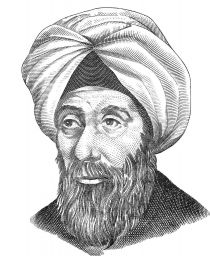|
|
Alhazen, också kallad Ibn Al-Haithem. Arabisk matematiker.
|
Alhazen, också kallad Ibn Al-Haithem. Arabisk matematiker i Kairo, född i Basra i Persien. Född 965 in Basra i dåtida Persien, nutida Irak, död ~1039 i Kairo.
Hela namnet enl. Wikipedia: Abū ‘Alī al-Ḥasan ibn al-Ḥasan ibn al-Haytham.
Wikipedia:
Ibn al-Haytham is regarded as the "father of modern optics"[15] for his influential Book of Optics which proved the intromission theory of vision and refined it into essentially its modern form. He is also recognized so for his experiments on optics, including experiments on lenses, mirrors, refraction, reflection, and the dispersion of light into its constituent colours.[16] He studied binocular vision and the Moon illusion, described the finite speed[17][18] of light, and argued that it is made of particles[19] travelling in straight lines.[18][20] Due to his formulation of a modern quantitative and empirical approach to physics and science, he is considered the pioneer of the modern scientific method[21][22] and the originator of the experimental nature of physics[23] and science.[24] Author Bradley Steffens describes him as the "first scientist".[25] He is also considered by A. I. Sabra to be the founder of experimental psychology[26] for his approach to visual perception and optical illusions,[27] and a pioneer of the philosophical field of phenomenology or the study of consciousness from a first-person perspective. His Book of Optics has been ranked with Isaac Newton's Philosophiae Naturalis Principia Mathematica as one of the most influential books in the history of physics,[28] for starting a revolution in optics[29] and visual perception.[30]
Ibn al-Haytham's achievements include many advances in physics and mathematics. He gave the first clear description[31] and correct analysis[32] of the camera obscura. He enunciated Fermat's principle of least time and the concept of inertia (Newton's first law of motion),[33] and developed the concept of momentum.[34] He described the attraction between masses an
|
|





![Klicka på bilden för att se den i fullstorlek
==============
Alhazen, också kallad Ibn Al-Haithem. Arabisk matematiker.
Alhazen, också kallad Ibn Al-Haithem. Arabisk matematiker i Kairo, född i Basra i Persien. Född 965 in Basra i dåtida Persien, nutida Irak, död ~1039 i Kairo.
Hela namnet enl. Wikipedia: Abū ‘Alī al-Ḥasan ibn al-Ḥasan ibn al-Haytham.
Wikipedia:
Ibn al-Haytham is regarded as the "father of modern optics"[15] for his influential Book of Optics which proved the intromission theory of vision and refined it into essentially its modern form. He is also recognized so for his experiments on optics, including experiments on lenses, mirrors, refraction, reflection, and the dispersion of light into its constituent colours.[16] He studied binocular vision and the Moon illusion, described the finite speed[17][18] of light, and argued that it is made of particles[19] travelling in straight lines.[18][20] Due to his formulation of a modern quantitative and empirical approach to physics and science, he is considered the pioneer of the modern scientific method[21][22] and the originator of the experimental nature of physics[23] and science.[24] Author Bradley Steffens describes him as the "first scientist".[25] He is also considered by A. I. Sabra to be the founder of experimental psychology[26] for his approach to visual perception and optical illusions,[27] and a pioneer of the philosophical field of phenomenology or the study of consciousness from a first-person perspective. His Book of Optics has been ranked with Isaac Newton's Philosophiae Naturalis Principia Mathematica as one of the most influential books in the history of physics,[28] for starting a revolution in optics[29] and visual perception.[30]
Ibn al-Haytham's achievements include many advances in physics and mathematics. He gave the first clear description[31] and correct analysis[32] of the camera obscura. He enunciated Fermat's principle of least time and the concept of inertia (Newton's first law of motion),[33] and developed the concept of momentum.[34] He described the attraction between masses an
Nyckelord: Matematiker;Mellanöstern;Främre Orienten;Iransk;900-talet;Arabisk Alhazen, också kallad Ibn Al-Haithem. Arabisk matematiker.
Alhazen, också kallad Ibn Al-Haithem. Arabisk matematiker i Kairo, född i Basra i Persien. Född 965 in Basra i dåtida Persien, nutida Irak, död ~1039 i Kairo.
Hela namnet enl. Wikipedia: Abū ‘Alī al-Ḥasan ibn al-Ḥasan ibn al-Haytham.
Wikipedia:
Ibn al-Haytham is regarded as the "father of modern optics"[15] for his influential Book of Optics which proved the intromission theory of vision and refined it into essentially its modern form. He is also recognized so for his experiments on optics, including experiments on lenses, mirrors, refraction, reflection, and the dispersion of light into its constituent colours.[16] He studied binocular vision and the Moon illusion, described the finite speed[17][18] of light, and argued that it is made of particles[19] travelling in straight lines.[18][20] Due to his formulation of a modern quantitative and empirical approach to physics and science, he is considered the pioneer of the modern scientific method[21][22] and the originator of the experimental nature of physics[23] and science.[24] Author Bradley Steffens describes him as the "first scientist".[25] He is also considered by A. I. Sabra to be the founder of experimental psychology[26] for his approach to visual perception and optical illusions,[27] and a pioneer of the philosophical field of phenomenology or the study of consciousness from a first-person perspective. His Book of Optics has been ranked with Isaac Newton's Philosophiae Naturalis Principia Mathematica as one of the most influential books in the history of physics,[28] for starting a revolution in optics[29] and visual perception.[30]
Ibn al-Haytham's achievements include many advances in physics and mathematics. He gave the first clear description[31] and correct analysis[32] of the camera obscura. He enunciated Fermat's principle of least time and the concept of inertia (Newton's first law of motion),[33] and developed the concept of momentum.[34] He described the attraction between masses an
Nyckelord: Matematiker;Mellanöstern;Främre Orienten;Iransk;900-talet;Arabisk](albums/userpics/10002/normal_Ibn_al-HaythamCpg.jpg)



